Leadership & Change: Building Organisational Capacity in Healthcare
VerifiedAdded on 2023/06/11
|15
|4291
|200
Report
AI Summary
This report examines the critical role of leadership in building organisational capacity within the healthcare sector. It discusses the importance of change management, highlighting the need for leaders to establish a clear vision, foster innovation, and manage change effectively. Various leadership styles, including transformational and participative leadership, are explored in relation to their impact on organisational culture and the successful implementation of change. The report also delves into Kotter's eight-stage change model, emphasizing the significance of creating a sense of urgency, establishing a guiding coalition, and communicating the vision for change. Furthermore, the importance of workplace culture and its influence on the change management process is analysed, along with strategies for managing cultural change. The report concludes by addressing the challenges and facilitators associated with building organisational capacity in healthcare, underscoring the need for visionary leadership and innovative solutions to improve the quality of healthcare services.
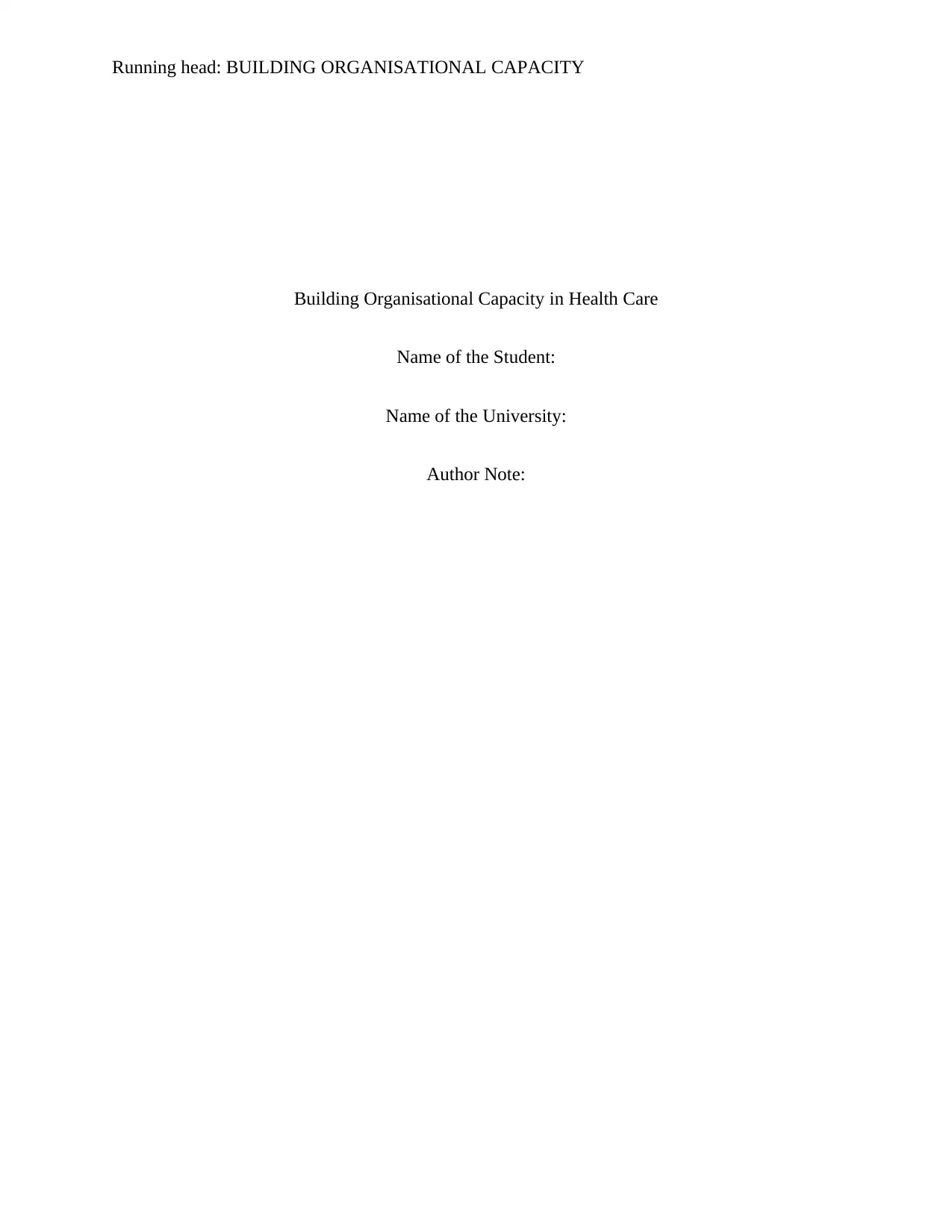
Running head: BUILDING ORGANISATIONAL CAPACITY
Building Organisational Capacity in Health Care
Name of the Student:
Name of the University:
Author Note:
Building Organisational Capacity in Health Care
Name of the Student:
Name of the University:
Author Note:
Paraphrase This Document
Need a fresh take? Get an instant paraphrase of this document with our AI Paraphraser
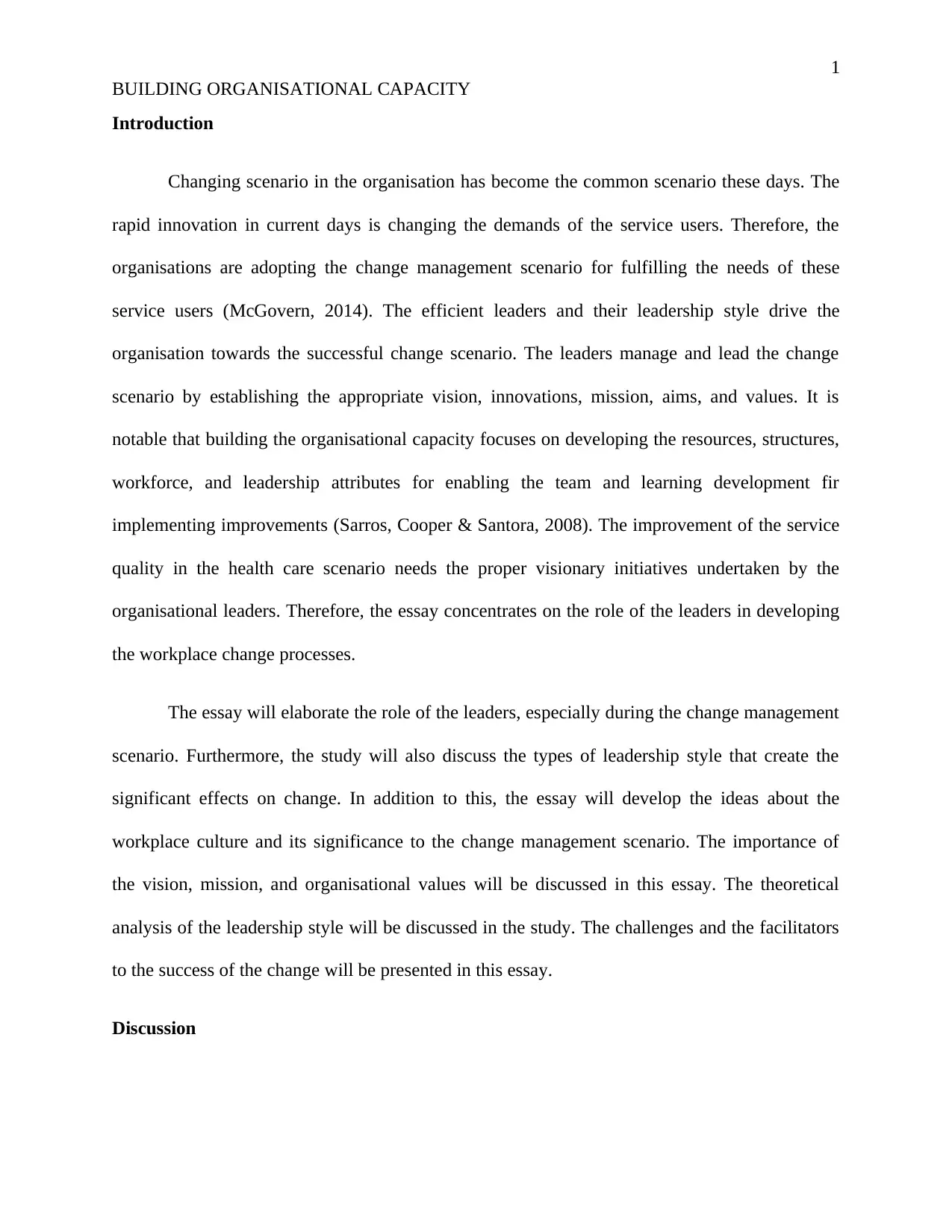
1
BUILDING ORGANISATIONAL CAPACITY
Introduction
Changing scenario in the organisation has become the common scenario these days. The
rapid innovation in current days is changing the demands of the service users. Therefore, the
organisations are adopting the change management scenario for fulfilling the needs of these
service users (McGovern, 2014). The efficient leaders and their leadership style drive the
organisation towards the successful change scenario. The leaders manage and lead the change
scenario by establishing the appropriate vision, innovations, mission, aims, and values. It is
notable that building the organisational capacity focuses on developing the resources, structures,
workforce, and leadership attributes for enabling the team and learning development fir
implementing improvements (Sarros, Cooper & Santora, 2008). The improvement of the service
quality in the health care scenario needs the proper visionary initiatives undertaken by the
organisational leaders. Therefore, the essay concentrates on the role of the leaders in developing
the workplace change processes.
The essay will elaborate the role of the leaders, especially during the change management
scenario. Furthermore, the study will also discuss the types of leadership style that create the
significant effects on change. In addition to this, the essay will develop the ideas about the
workplace culture and its significance to the change management scenario. The importance of
the vision, mission, and organisational values will be discussed in this essay. The theoretical
analysis of the leadership style will be discussed in the study. The challenges and the facilitators
to the success of the change will be presented in this essay.
Discussion
BUILDING ORGANISATIONAL CAPACITY
Introduction
Changing scenario in the organisation has become the common scenario these days. The
rapid innovation in current days is changing the demands of the service users. Therefore, the
organisations are adopting the change management scenario for fulfilling the needs of these
service users (McGovern, 2014). The efficient leaders and their leadership style drive the
organisation towards the successful change scenario. The leaders manage and lead the change
scenario by establishing the appropriate vision, innovations, mission, aims, and values. It is
notable that building the organisational capacity focuses on developing the resources, structures,
workforce, and leadership attributes for enabling the team and learning development fir
implementing improvements (Sarros, Cooper & Santora, 2008). The improvement of the service
quality in the health care scenario needs the proper visionary initiatives undertaken by the
organisational leaders. Therefore, the essay concentrates on the role of the leaders in developing
the workplace change processes.
The essay will elaborate the role of the leaders, especially during the change management
scenario. Furthermore, the study will also discuss the types of leadership style that create the
significant effects on change. In addition to this, the essay will develop the ideas about the
workplace culture and its significance to the change management scenario. The importance of
the vision, mission, and organisational values will be discussed in this essay. The theoretical
analysis of the leadership style will be discussed in the study. The challenges and the facilitators
to the success of the change will be presented in this essay.
Discussion
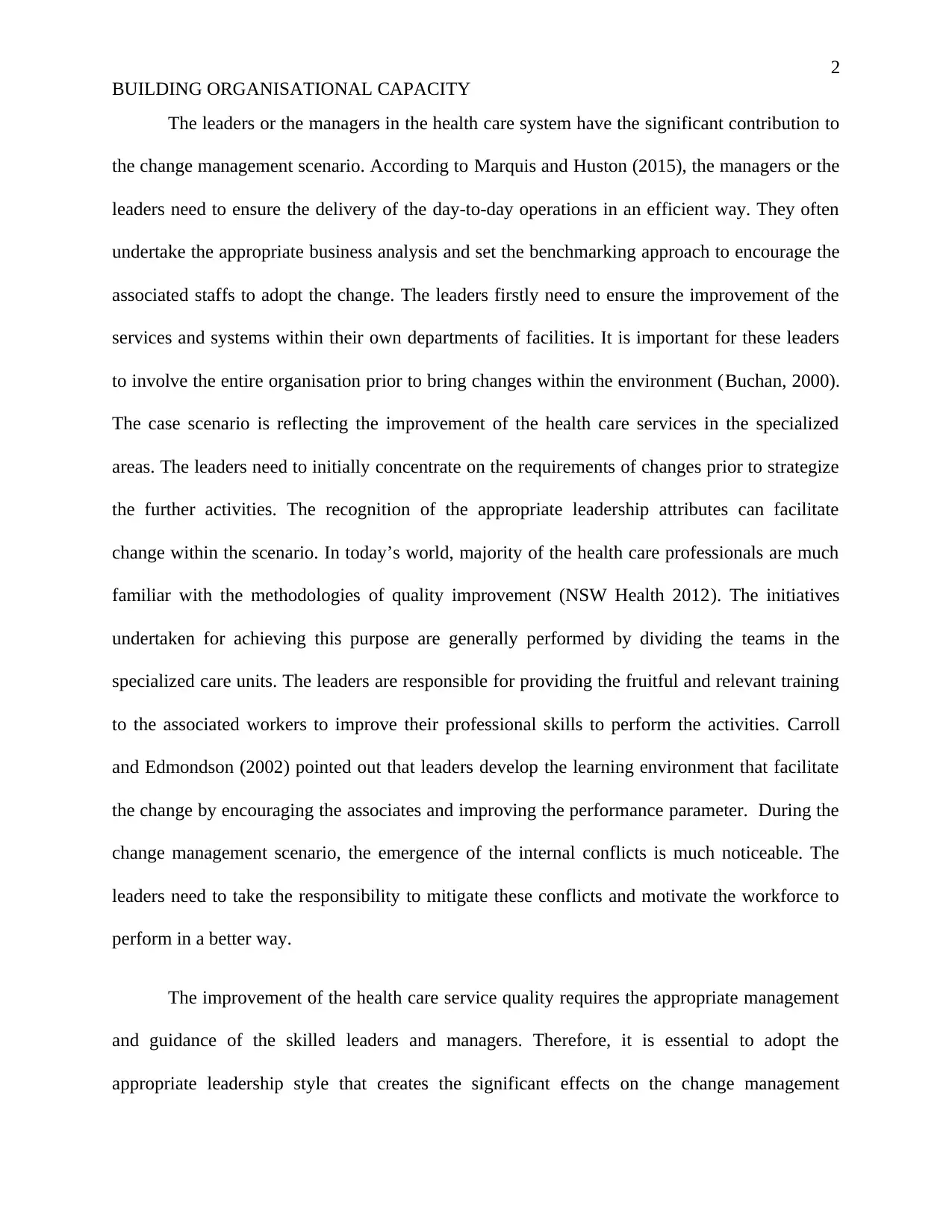
2
BUILDING ORGANISATIONAL CAPACITY
The leaders or the managers in the health care system have the significant contribution to
the change management scenario. According to Marquis and Huston (2015), the managers or the
leaders need to ensure the delivery of the day-to-day operations in an efficient way. They often
undertake the appropriate business analysis and set the benchmarking approach to encourage the
associated staffs to adopt the change. The leaders firstly need to ensure the improvement of the
services and systems within their own departments of facilities. It is important for these leaders
to involve the entire organisation prior to bring changes within the environment (Buchan, 2000).
The case scenario is reflecting the improvement of the health care services in the specialized
areas. The leaders need to initially concentrate on the requirements of changes prior to strategize
the further activities. The recognition of the appropriate leadership attributes can facilitate
change within the scenario. In today’s world, majority of the health care professionals are much
familiar with the methodologies of quality improvement (NSW Health 2012). The initiatives
undertaken for achieving this purpose are generally performed by dividing the teams in the
specialized care units. The leaders are responsible for providing the fruitful and relevant training
to the associated workers to improve their professional skills to perform the activities. Carroll
and Edmondson (2002) pointed out that leaders develop the learning environment that facilitate
the change by encouraging the associates and improving the performance parameter. During the
change management scenario, the emergence of the internal conflicts is much noticeable. The
leaders need to take the responsibility to mitigate these conflicts and motivate the workforce to
perform in a better way.
The improvement of the health care service quality requires the appropriate management
and guidance of the skilled leaders and managers. Therefore, it is essential to adopt the
appropriate leadership style that creates the significant effects on the change management
BUILDING ORGANISATIONAL CAPACITY
The leaders or the managers in the health care system have the significant contribution to
the change management scenario. According to Marquis and Huston (2015), the managers or the
leaders need to ensure the delivery of the day-to-day operations in an efficient way. They often
undertake the appropriate business analysis and set the benchmarking approach to encourage the
associated staffs to adopt the change. The leaders firstly need to ensure the improvement of the
services and systems within their own departments of facilities. It is important for these leaders
to involve the entire organisation prior to bring changes within the environment (Buchan, 2000).
The case scenario is reflecting the improvement of the health care services in the specialized
areas. The leaders need to initially concentrate on the requirements of changes prior to strategize
the further activities. The recognition of the appropriate leadership attributes can facilitate
change within the scenario. In today’s world, majority of the health care professionals are much
familiar with the methodologies of quality improvement (NSW Health 2012). The initiatives
undertaken for achieving this purpose are generally performed by dividing the teams in the
specialized care units. The leaders are responsible for providing the fruitful and relevant training
to the associated workers to improve their professional skills to perform the activities. Carroll
and Edmondson (2002) pointed out that leaders develop the learning environment that facilitate
the change by encouraging the associates and improving the performance parameter. During the
change management scenario, the emergence of the internal conflicts is much noticeable. The
leaders need to take the responsibility to mitigate these conflicts and motivate the workforce to
perform in a better way.
The improvement of the health care service quality requires the appropriate management
and guidance of the skilled leaders and managers. Therefore, it is essential to adopt the
appropriate leadership style that creates the significant effects on the change management
⊘ This is a preview!⊘
Do you want full access?
Subscribe today to unlock all pages.

Trusted by 1+ million students worldwide
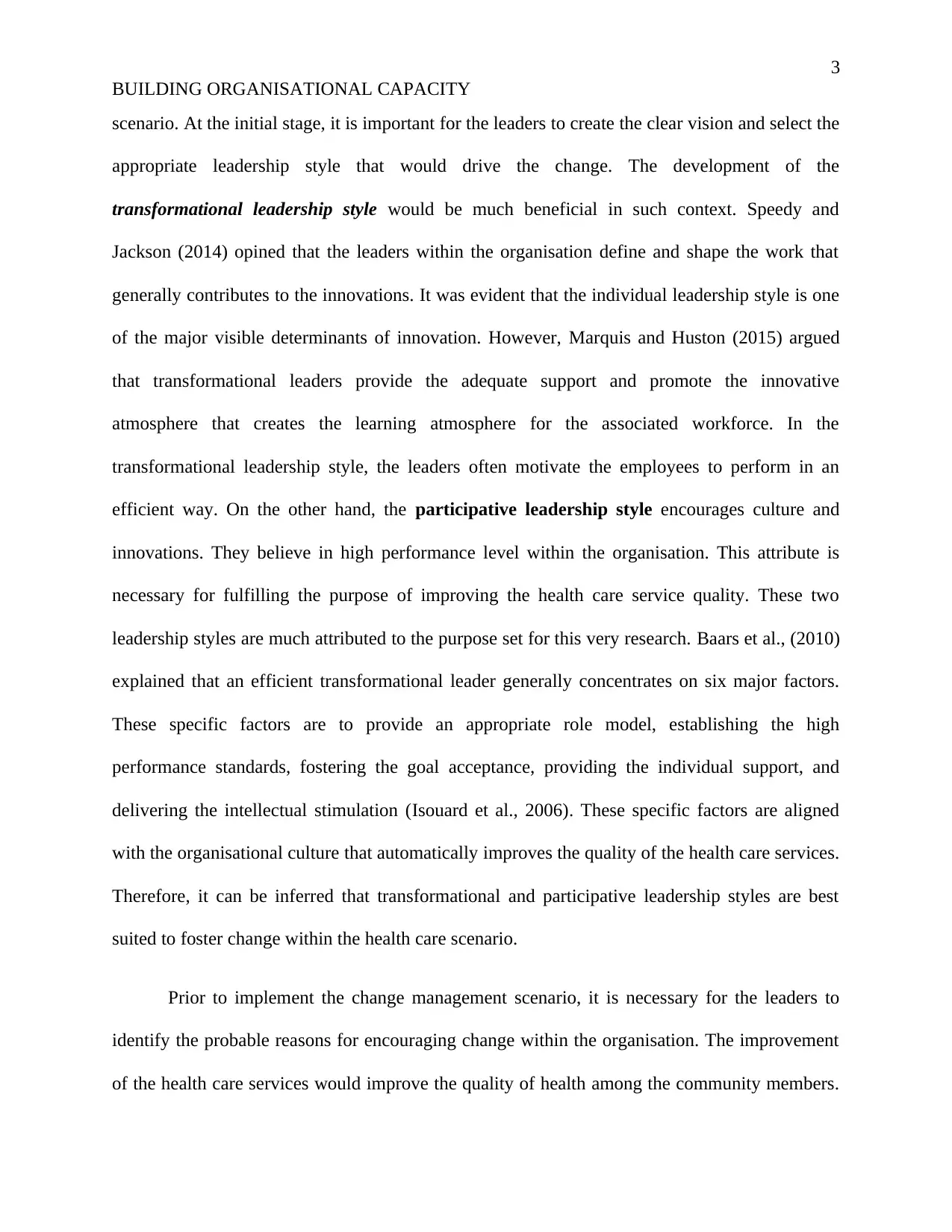
3
BUILDING ORGANISATIONAL CAPACITY
scenario. At the initial stage, it is important for the leaders to create the clear vision and select the
appropriate leadership style that would drive the change. The development of the
transformational leadership style would be much beneficial in such context. Speedy and
Jackson (2014) opined that the leaders within the organisation define and shape the work that
generally contributes to the innovations. It was evident that the individual leadership style is one
of the major visible determinants of innovation. However, Marquis and Huston (2015) argued
that transformational leaders provide the adequate support and promote the innovative
atmosphere that creates the learning atmosphere for the associated workforce. In the
transformational leadership style, the leaders often motivate the employees to perform in an
efficient way. On the other hand, the participative leadership style encourages culture and
innovations. They believe in high performance level within the organisation. This attribute is
necessary for fulfilling the purpose of improving the health care service quality. These two
leadership styles are much attributed to the purpose set for this very research. Baars et al., (2010)
explained that an efficient transformational leader generally concentrates on six major factors.
These specific factors are to provide an appropriate role model, establishing the high
performance standards, fostering the goal acceptance, providing the individual support, and
delivering the intellectual stimulation (Isouard et al., 2006). These specific factors are aligned
with the organisational culture that automatically improves the quality of the health care services.
Therefore, it can be inferred that transformational and participative leadership styles are best
suited to foster change within the health care scenario.
Prior to implement the change management scenario, it is necessary for the leaders to
identify the probable reasons for encouraging change within the organisation. The improvement
of the health care services would improve the quality of health among the community members.
BUILDING ORGANISATIONAL CAPACITY
scenario. At the initial stage, it is important for the leaders to create the clear vision and select the
appropriate leadership style that would drive the change. The development of the
transformational leadership style would be much beneficial in such context. Speedy and
Jackson (2014) opined that the leaders within the organisation define and shape the work that
generally contributes to the innovations. It was evident that the individual leadership style is one
of the major visible determinants of innovation. However, Marquis and Huston (2015) argued
that transformational leaders provide the adequate support and promote the innovative
atmosphere that creates the learning atmosphere for the associated workforce. In the
transformational leadership style, the leaders often motivate the employees to perform in an
efficient way. On the other hand, the participative leadership style encourages culture and
innovations. They believe in high performance level within the organisation. This attribute is
necessary for fulfilling the purpose of improving the health care service quality. These two
leadership styles are much attributed to the purpose set for this very research. Baars et al., (2010)
explained that an efficient transformational leader generally concentrates on six major factors.
These specific factors are to provide an appropriate role model, establishing the high
performance standards, fostering the goal acceptance, providing the individual support, and
delivering the intellectual stimulation (Isouard et al., 2006). These specific factors are aligned
with the organisational culture that automatically improves the quality of the health care services.
Therefore, it can be inferred that transformational and participative leadership styles are best
suited to foster change within the health care scenario.
Prior to implement the change management scenario, it is necessary for the leaders to
identify the probable reasons for encouraging change within the organisation. The improvement
of the health care services would improve the quality of health among the community members.
Paraphrase This Document
Need a fresh take? Get an instant paraphrase of this document with our AI Paraphraser
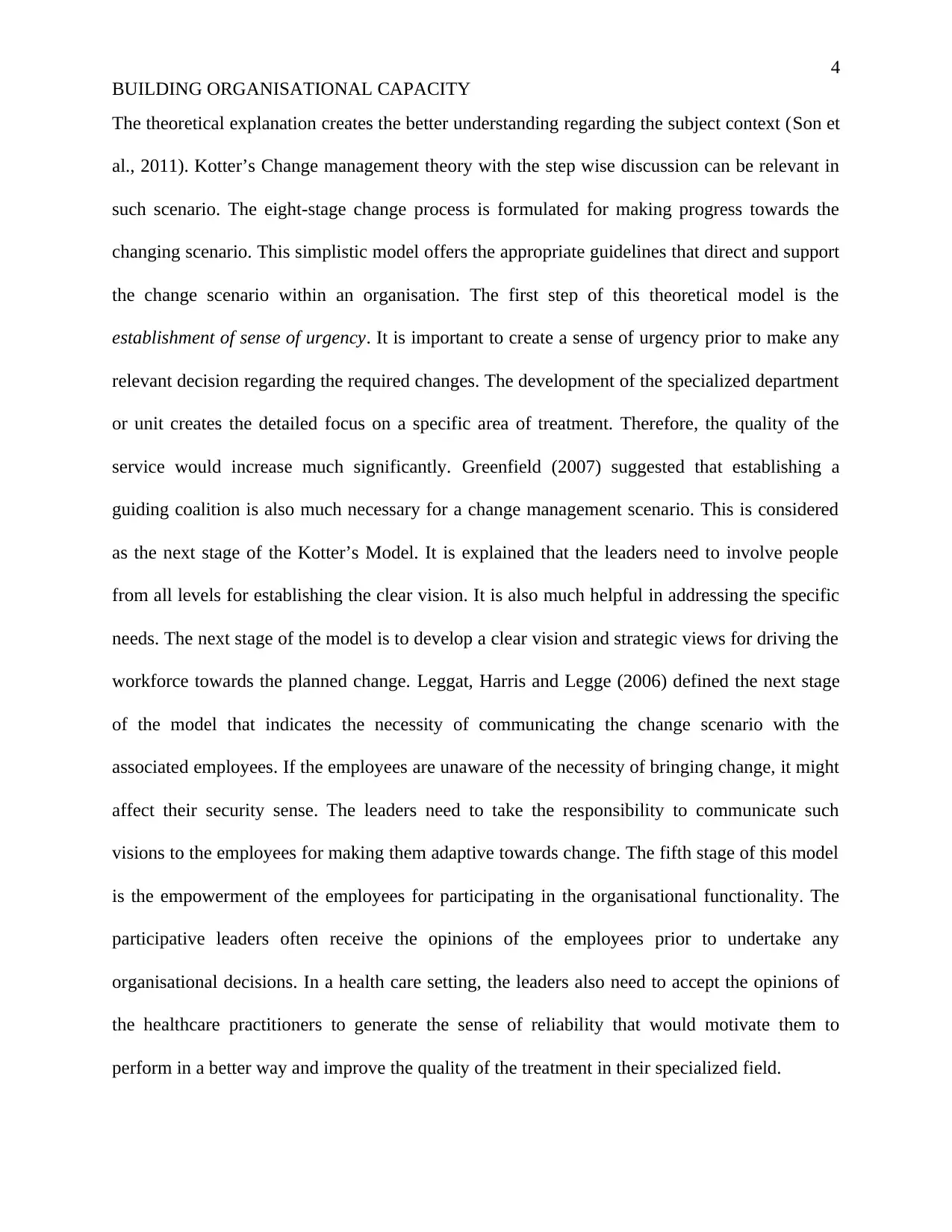
4
BUILDING ORGANISATIONAL CAPACITY
The theoretical explanation creates the better understanding regarding the subject context (Son et
al., 2011). Kotter’s Change management theory with the step wise discussion can be relevant in
such scenario. The eight-stage change process is formulated for making progress towards the
changing scenario. This simplistic model offers the appropriate guidelines that direct and support
the change scenario within an organisation. The first step of this theoretical model is the
establishment of sense of urgency. It is important to create a sense of urgency prior to make any
relevant decision regarding the required changes. The development of the specialized department
or unit creates the detailed focus on a specific area of treatment. Therefore, the quality of the
service would increase much significantly. Greenfield (2007) suggested that establishing a
guiding coalition is also much necessary for a change management scenario. This is considered
as the next stage of the Kotter’s Model. It is explained that the leaders need to involve people
from all levels for establishing the clear vision. It is also much helpful in addressing the specific
needs. The next stage of the model is to develop a clear vision and strategic views for driving the
workforce towards the planned change. Leggat, Harris and Legge (2006) defined the next stage
of the model that indicates the necessity of communicating the change scenario with the
associated employees. If the employees are unaware of the necessity of bringing change, it might
affect their security sense. The leaders need to take the responsibility to communicate such
visions to the employees for making them adaptive towards change. The fifth stage of this model
is the empowerment of the employees for participating in the organisational functionality. The
participative leaders often receive the opinions of the employees prior to undertake any
organisational decisions. In a health care setting, the leaders also need to accept the opinions of
the healthcare practitioners to generate the sense of reliability that would motivate them to
perform in a better way and improve the quality of the treatment in their specialized field.
BUILDING ORGANISATIONAL CAPACITY
The theoretical explanation creates the better understanding regarding the subject context (Son et
al., 2011). Kotter’s Change management theory with the step wise discussion can be relevant in
such scenario. The eight-stage change process is formulated for making progress towards the
changing scenario. This simplistic model offers the appropriate guidelines that direct and support
the change scenario within an organisation. The first step of this theoretical model is the
establishment of sense of urgency. It is important to create a sense of urgency prior to make any
relevant decision regarding the required changes. The development of the specialized department
or unit creates the detailed focus on a specific area of treatment. Therefore, the quality of the
service would increase much significantly. Greenfield (2007) suggested that establishing a
guiding coalition is also much necessary for a change management scenario. This is considered
as the next stage of the Kotter’s Model. It is explained that the leaders need to involve people
from all levels for establishing the clear vision. It is also much helpful in addressing the specific
needs. The next stage of the model is to develop a clear vision and strategic views for driving the
workforce towards the planned change. Leggat, Harris and Legge (2006) defined the next stage
of the model that indicates the necessity of communicating the change scenario with the
associated employees. If the employees are unaware of the necessity of bringing change, it might
affect their security sense. The leaders need to take the responsibility to communicate such
visions to the employees for making them adaptive towards change. The fifth stage of this model
is the empowerment of the employees for participating in the organisational functionality. The
participative leaders often receive the opinions of the employees prior to undertake any
organisational decisions. In a health care setting, the leaders also need to accept the opinions of
the healthcare practitioners to generate the sense of reliability that would motivate them to
perform in a better way and improve the quality of the treatment in their specialized field.
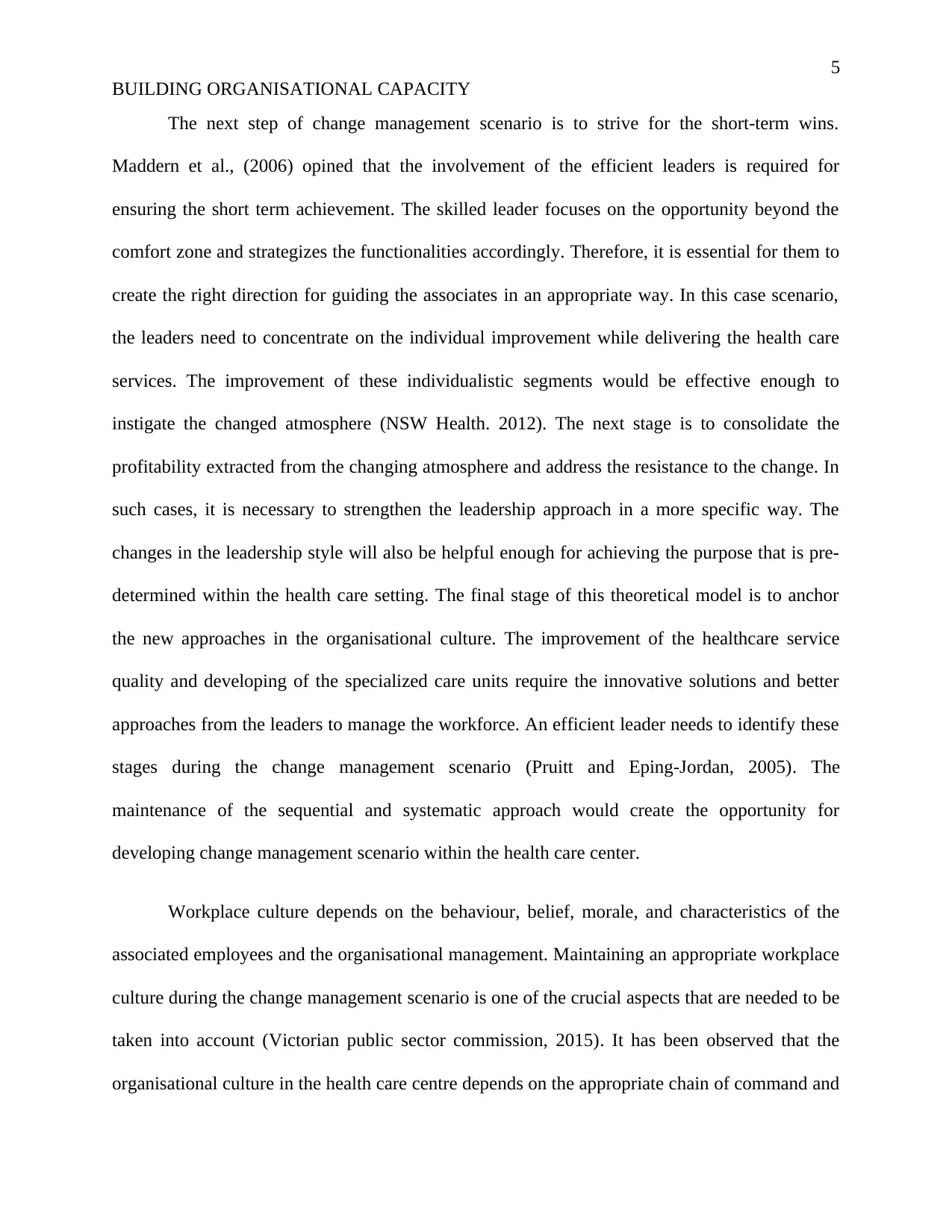
5
BUILDING ORGANISATIONAL CAPACITY
The next step of change management scenario is to strive for the short-term wins.
Maddern et al., (2006) opined that the involvement of the efficient leaders is required for
ensuring the short term achievement. The skilled leader focuses on the opportunity beyond the
comfort zone and strategizes the functionalities accordingly. Therefore, it is essential for them to
create the right direction for guiding the associates in an appropriate way. In this case scenario,
the leaders need to concentrate on the individual improvement while delivering the health care
services. The improvement of these individualistic segments would be effective enough to
instigate the changed atmosphere (NSW Health. 2012). The next stage is to consolidate the
profitability extracted from the changing atmosphere and address the resistance to the change. In
such cases, it is necessary to strengthen the leadership approach in a more specific way. The
changes in the leadership style will also be helpful enough for achieving the purpose that is pre-
determined within the health care setting. The final stage of this theoretical model is to anchor
the new approaches in the organisational culture. The improvement of the healthcare service
quality and developing of the specialized care units require the innovative solutions and better
approaches from the leaders to manage the workforce. An efficient leader needs to identify these
stages during the change management scenario (Pruitt and Eping-Jordan, 2005). The
maintenance of the sequential and systematic approach would create the opportunity for
developing change management scenario within the health care center.
Workplace culture depends on the behaviour, belief, morale, and characteristics of the
associated employees and the organisational management. Maintaining an appropriate workplace
culture during the change management scenario is one of the crucial aspects that are needed to be
taken into account (Victorian public sector commission, 2015). It has been observed that the
organisational culture in the health care centre depends on the appropriate chain of command and
BUILDING ORGANISATIONAL CAPACITY
The next step of change management scenario is to strive for the short-term wins.
Maddern et al., (2006) opined that the involvement of the efficient leaders is required for
ensuring the short term achievement. The skilled leader focuses on the opportunity beyond the
comfort zone and strategizes the functionalities accordingly. Therefore, it is essential for them to
create the right direction for guiding the associates in an appropriate way. In this case scenario,
the leaders need to concentrate on the individual improvement while delivering the health care
services. The improvement of these individualistic segments would be effective enough to
instigate the changed atmosphere (NSW Health. 2012). The next stage is to consolidate the
profitability extracted from the changing atmosphere and address the resistance to the change. In
such cases, it is necessary to strengthen the leadership approach in a more specific way. The
changes in the leadership style will also be helpful enough for achieving the purpose that is pre-
determined within the health care setting. The final stage of this theoretical model is to anchor
the new approaches in the organisational culture. The improvement of the healthcare service
quality and developing of the specialized care units require the innovative solutions and better
approaches from the leaders to manage the workforce. An efficient leader needs to identify these
stages during the change management scenario (Pruitt and Eping-Jordan, 2005). The
maintenance of the sequential and systematic approach would create the opportunity for
developing change management scenario within the health care center.
Workplace culture depends on the behaviour, belief, morale, and characteristics of the
associated employees and the organisational management. Maintaining an appropriate workplace
culture during the change management scenario is one of the crucial aspects that are needed to be
taken into account (Victorian public sector commission, 2015). It has been observed that the
organisational culture in the health care centre depends on the appropriate chain of command and
⊘ This is a preview!⊘
Do you want full access?
Subscribe today to unlock all pages.

Trusted by 1+ million students worldwide
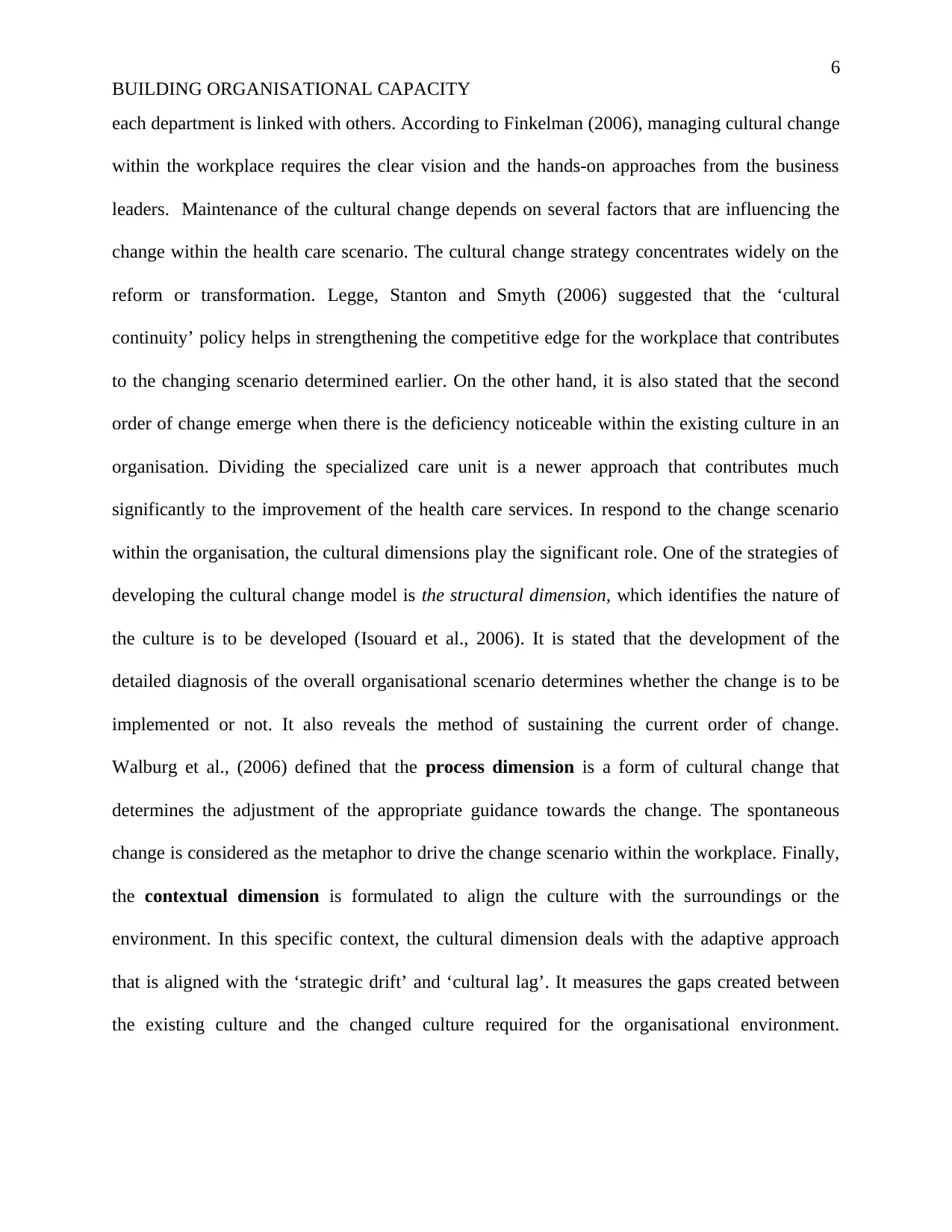
6
BUILDING ORGANISATIONAL CAPACITY
each department is linked with others. According to Finkelman (2006), managing cultural change
within the workplace requires the clear vision and the hands-on approaches from the business
leaders. Maintenance of the cultural change depends on several factors that are influencing the
change within the health care scenario. The cultural change strategy concentrates widely on the
reform or transformation. Legge, Stanton and Smyth (2006) suggested that the ‘cultural
continuity’ policy helps in strengthening the competitive edge for the workplace that contributes
to the changing scenario determined earlier. On the other hand, it is also stated that the second
order of change emerge when there is the deficiency noticeable within the existing culture in an
organisation. Dividing the specialized care unit is a newer approach that contributes much
significantly to the improvement of the health care services. In respond to the change scenario
within the organisation, the cultural dimensions play the significant role. One of the strategies of
developing the cultural change model is the structural dimension, which identifies the nature of
the culture is to be developed (Isouard et al., 2006). It is stated that the development of the
detailed diagnosis of the overall organisational scenario determines whether the change is to be
implemented or not. It also reveals the method of sustaining the current order of change.
Walburg et al., (2006) defined that the process dimension is a form of cultural change that
determines the adjustment of the appropriate guidance towards the change. The spontaneous
change is considered as the metaphor to drive the change scenario within the workplace. Finally,
the contextual dimension is formulated to align the culture with the surroundings or the
environment. In this specific context, the cultural dimension deals with the adaptive approach
that is aligned with the ‘strategic drift’ and ‘cultural lag’. It measures the gaps created between
the existing culture and the changed culture required for the organisational environment.
BUILDING ORGANISATIONAL CAPACITY
each department is linked with others. According to Finkelman (2006), managing cultural change
within the workplace requires the clear vision and the hands-on approaches from the business
leaders. Maintenance of the cultural change depends on several factors that are influencing the
change within the health care scenario. The cultural change strategy concentrates widely on the
reform or transformation. Legge, Stanton and Smyth (2006) suggested that the ‘cultural
continuity’ policy helps in strengthening the competitive edge for the workplace that contributes
to the changing scenario determined earlier. On the other hand, it is also stated that the second
order of change emerge when there is the deficiency noticeable within the existing culture in an
organisation. Dividing the specialized care unit is a newer approach that contributes much
significantly to the improvement of the health care services. In respond to the change scenario
within the organisation, the cultural dimensions play the significant role. One of the strategies of
developing the cultural change model is the structural dimension, which identifies the nature of
the culture is to be developed (Isouard et al., 2006). It is stated that the development of the
detailed diagnosis of the overall organisational scenario determines whether the change is to be
implemented or not. It also reveals the method of sustaining the current order of change.
Walburg et al., (2006) defined that the process dimension is a form of cultural change that
determines the adjustment of the appropriate guidance towards the change. The spontaneous
change is considered as the metaphor to drive the change scenario within the workplace. Finally,
the contextual dimension is formulated to align the culture with the surroundings or the
environment. In this specific context, the cultural dimension deals with the adaptive approach
that is aligned with the ‘strategic drift’ and ‘cultural lag’. It measures the gaps created between
the existing culture and the changed culture required for the organisational environment.
Paraphrase This Document
Need a fresh take? Get an instant paraphrase of this document with our AI Paraphraser
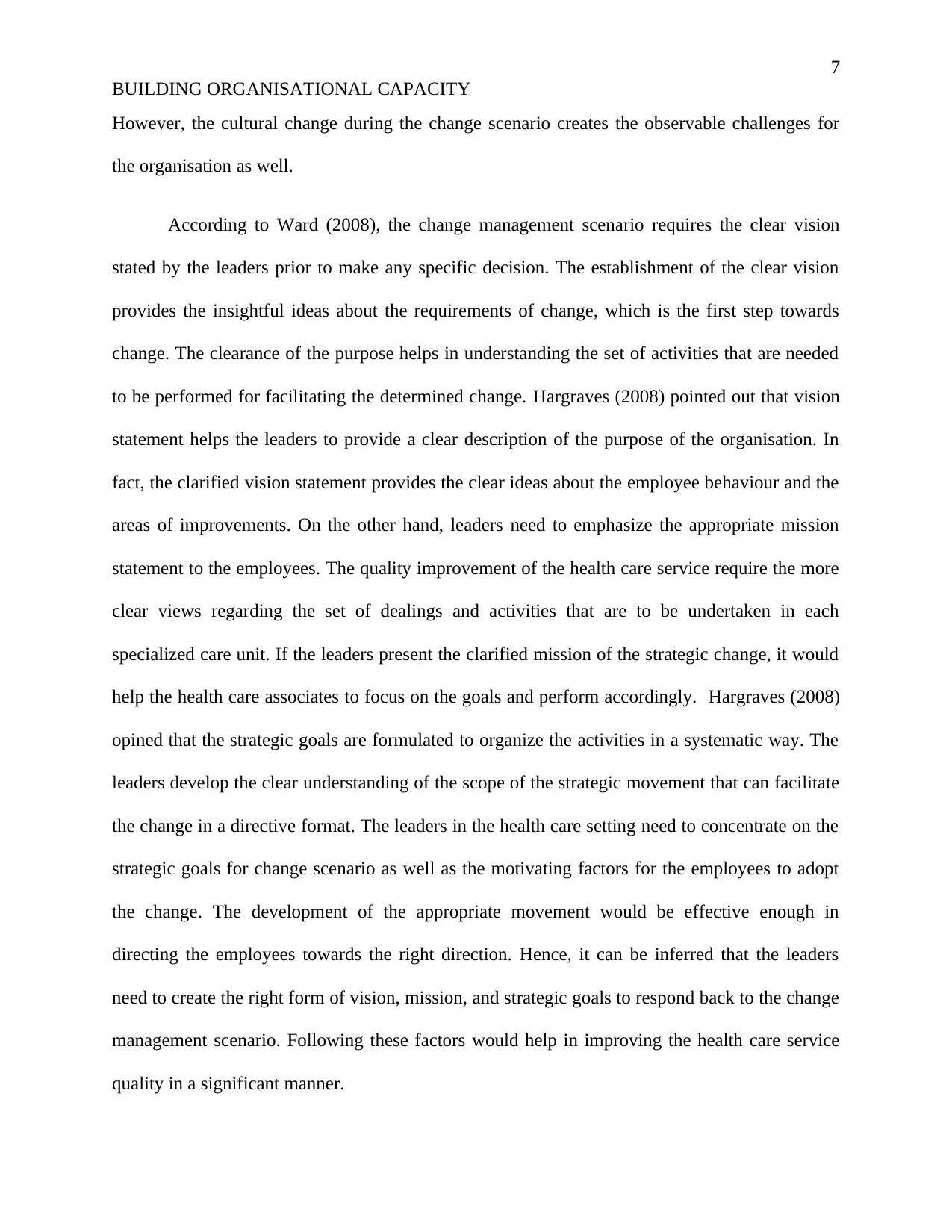
7
BUILDING ORGANISATIONAL CAPACITY
However, the cultural change during the change scenario creates the observable challenges for
the organisation as well.
According to Ward (2008), the change management scenario requires the clear vision
stated by the leaders prior to make any specific decision. The establishment of the clear vision
provides the insightful ideas about the requirements of change, which is the first step towards
change. The clearance of the purpose helps in understanding the set of activities that are needed
to be performed for facilitating the determined change. Hargraves (2008) pointed out that vision
statement helps the leaders to provide a clear description of the purpose of the organisation. In
fact, the clarified vision statement provides the clear ideas about the employee behaviour and the
areas of improvements. On the other hand, leaders need to emphasize the appropriate mission
statement to the employees. The quality improvement of the health care service require the more
clear views regarding the set of dealings and activities that are to be undertaken in each
specialized care unit. If the leaders present the clarified mission of the strategic change, it would
help the health care associates to focus on the goals and perform accordingly. Hargraves (2008)
opined that the strategic goals are formulated to organize the activities in a systematic way. The
leaders develop the clear understanding of the scope of the strategic movement that can facilitate
the change in a directive format. The leaders in the health care setting need to concentrate on the
strategic goals for change scenario as well as the motivating factors for the employees to adopt
the change. The development of the appropriate movement would be effective enough in
directing the employees towards the right direction. Hence, it can be inferred that the leaders
need to create the right form of vision, mission, and strategic goals to respond back to the change
management scenario. Following these factors would help in improving the health care service
quality in a significant manner.
BUILDING ORGANISATIONAL CAPACITY
However, the cultural change during the change scenario creates the observable challenges for
the organisation as well.
According to Ward (2008), the change management scenario requires the clear vision
stated by the leaders prior to make any specific decision. The establishment of the clear vision
provides the insightful ideas about the requirements of change, which is the first step towards
change. The clearance of the purpose helps in understanding the set of activities that are needed
to be performed for facilitating the determined change. Hargraves (2008) pointed out that vision
statement helps the leaders to provide a clear description of the purpose of the organisation. In
fact, the clarified vision statement provides the clear ideas about the employee behaviour and the
areas of improvements. On the other hand, leaders need to emphasize the appropriate mission
statement to the employees. The quality improvement of the health care service require the more
clear views regarding the set of dealings and activities that are to be undertaken in each
specialized care unit. If the leaders present the clarified mission of the strategic change, it would
help the health care associates to focus on the goals and perform accordingly. Hargraves (2008)
opined that the strategic goals are formulated to organize the activities in a systematic way. The
leaders develop the clear understanding of the scope of the strategic movement that can facilitate
the change in a directive format. The leaders in the health care setting need to concentrate on the
strategic goals for change scenario as well as the motivating factors for the employees to adopt
the change. The development of the appropriate movement would be effective enough in
directing the employees towards the right direction. Hence, it can be inferred that the leaders
need to create the right form of vision, mission, and strategic goals to respond back to the change
management scenario. Following these factors would help in improving the health care service
quality in a significant manner.
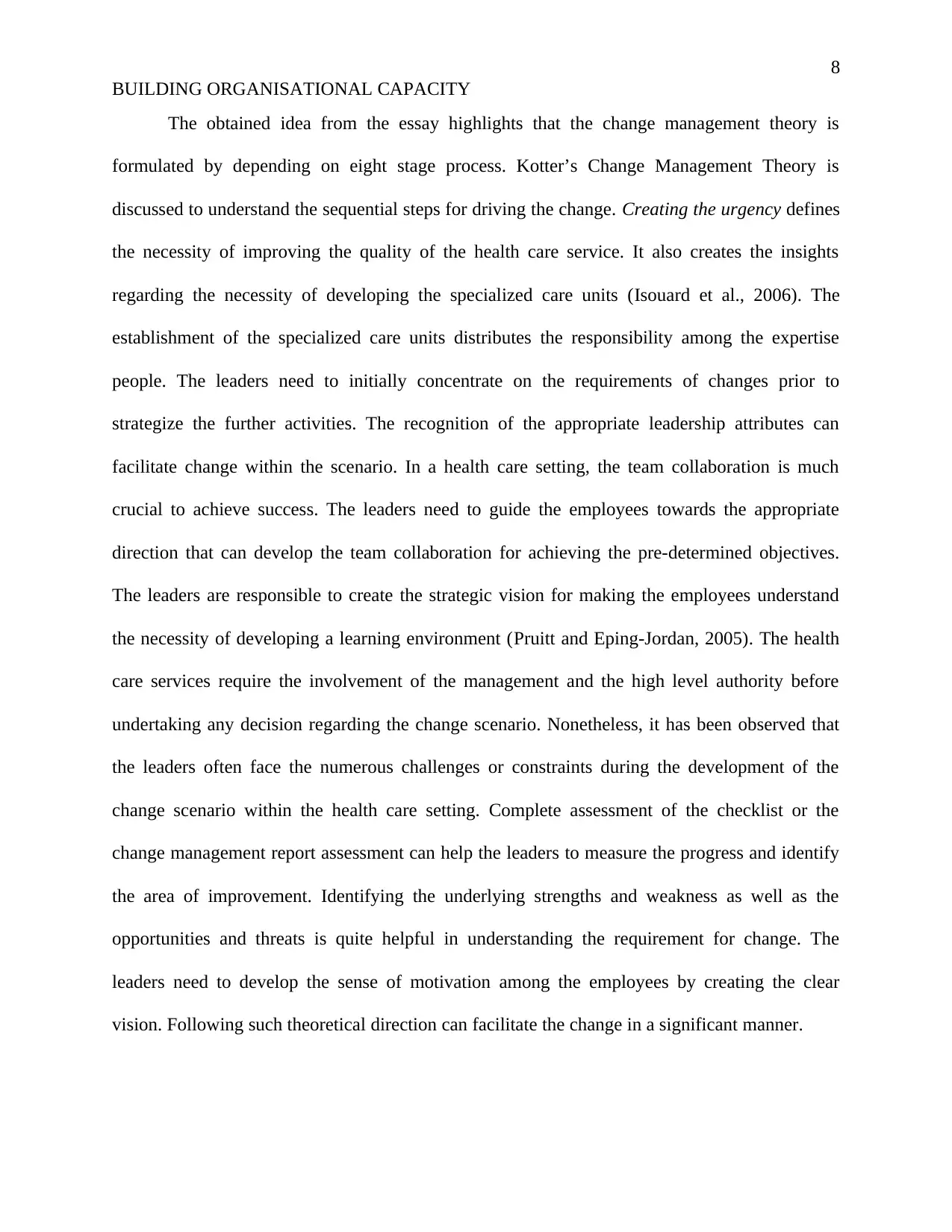
8
BUILDING ORGANISATIONAL CAPACITY
The obtained idea from the essay highlights that the change management theory is
formulated by depending on eight stage process. Kotter’s Change Management Theory is
discussed to understand the sequential steps for driving the change. Creating the urgency defines
the necessity of improving the quality of the health care service. It also creates the insights
regarding the necessity of developing the specialized care units (Isouard et al., 2006). The
establishment of the specialized care units distributes the responsibility among the expertise
people. The leaders need to initially concentrate on the requirements of changes prior to
strategize the further activities. The recognition of the appropriate leadership attributes can
facilitate change within the scenario. In a health care setting, the team collaboration is much
crucial to achieve success. The leaders need to guide the employees towards the appropriate
direction that can develop the team collaboration for achieving the pre-determined objectives.
The leaders are responsible to create the strategic vision for making the employees understand
the necessity of developing a learning environment (Pruitt and Eping-Jordan, 2005). The health
care services require the involvement of the management and the high level authority before
undertaking any decision regarding the change scenario. Nonetheless, it has been observed that
the leaders often face the numerous challenges or constraints during the development of the
change scenario within the health care setting. Complete assessment of the checklist or the
change management report assessment can help the leaders to measure the progress and identify
the area of improvement. Identifying the underlying strengths and weakness as well as the
opportunities and threats is quite helpful in understanding the requirement for change. The
leaders need to develop the sense of motivation among the employees by creating the clear
vision. Following such theoretical direction can facilitate the change in a significant manner.
BUILDING ORGANISATIONAL CAPACITY
The obtained idea from the essay highlights that the change management theory is
formulated by depending on eight stage process. Kotter’s Change Management Theory is
discussed to understand the sequential steps for driving the change. Creating the urgency defines
the necessity of improving the quality of the health care service. It also creates the insights
regarding the necessity of developing the specialized care units (Isouard et al., 2006). The
establishment of the specialized care units distributes the responsibility among the expertise
people. The leaders need to initially concentrate on the requirements of changes prior to
strategize the further activities. The recognition of the appropriate leadership attributes can
facilitate change within the scenario. In a health care setting, the team collaboration is much
crucial to achieve success. The leaders need to guide the employees towards the appropriate
direction that can develop the team collaboration for achieving the pre-determined objectives.
The leaders are responsible to create the strategic vision for making the employees understand
the necessity of developing a learning environment (Pruitt and Eping-Jordan, 2005). The health
care services require the involvement of the management and the high level authority before
undertaking any decision regarding the change scenario. Nonetheless, it has been observed that
the leaders often face the numerous challenges or constraints during the development of the
change scenario within the health care setting. Complete assessment of the checklist or the
change management report assessment can help the leaders to measure the progress and identify
the area of improvement. Identifying the underlying strengths and weakness as well as the
opportunities and threats is quite helpful in understanding the requirement for change. The
leaders need to develop the sense of motivation among the employees by creating the clear
vision. Following such theoretical direction can facilitate the change in a significant manner.
⊘ This is a preview!⊘
Do you want full access?
Subscribe today to unlock all pages.

Trusted by 1+ million students worldwide
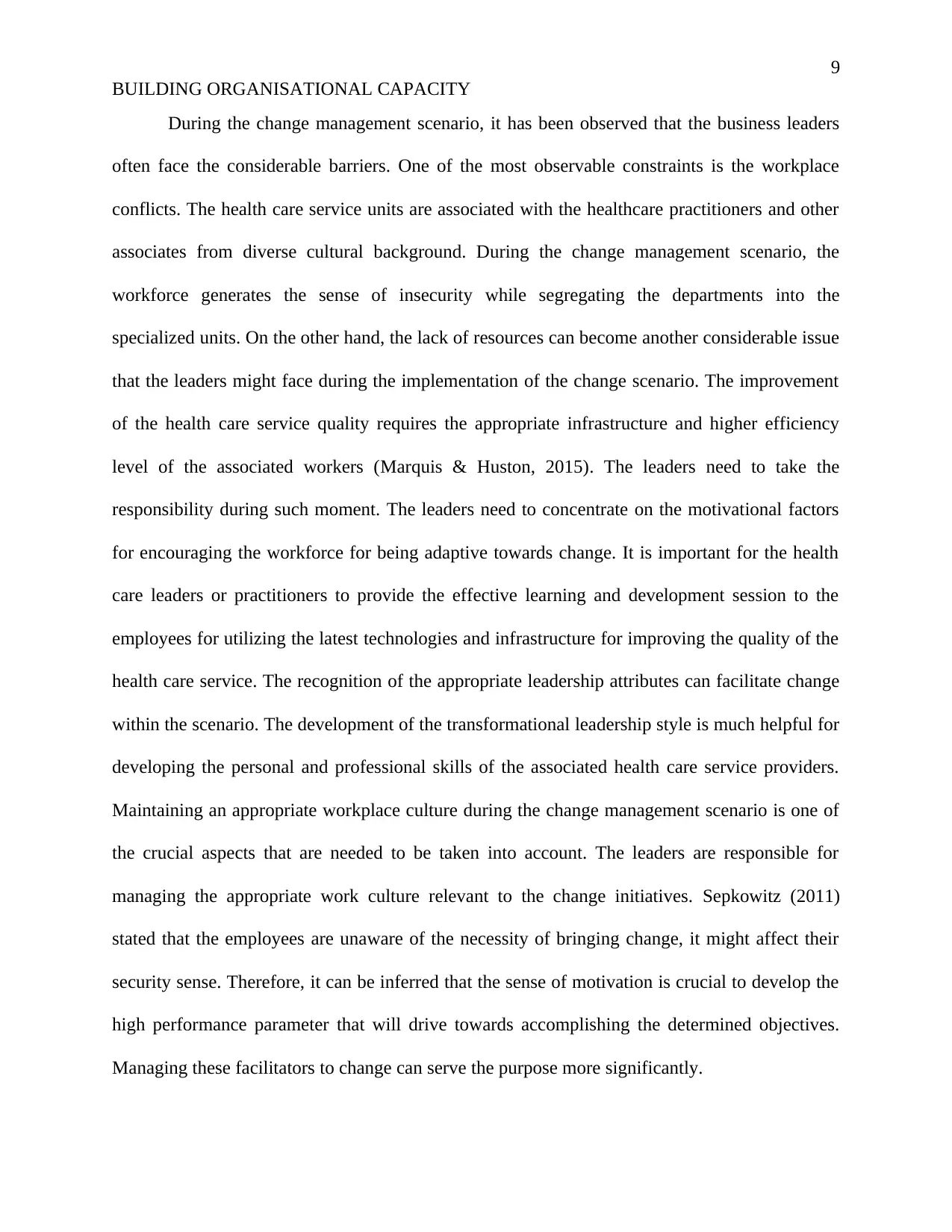
9
BUILDING ORGANISATIONAL CAPACITY
During the change management scenario, it has been observed that the business leaders
often face the considerable barriers. One of the most observable constraints is the workplace
conflicts. The health care service units are associated with the healthcare practitioners and other
associates from diverse cultural background. During the change management scenario, the
workforce generates the sense of insecurity while segregating the departments into the
specialized units. On the other hand, the lack of resources can become another considerable issue
that the leaders might face during the implementation of the change scenario. The improvement
of the health care service quality requires the appropriate infrastructure and higher efficiency
level of the associated workers (Marquis & Huston, 2015). The leaders need to take the
responsibility during such moment. The leaders need to concentrate on the motivational factors
for encouraging the workforce for being adaptive towards change. It is important for the health
care leaders or practitioners to provide the effective learning and development session to the
employees for utilizing the latest technologies and infrastructure for improving the quality of the
health care service. The recognition of the appropriate leadership attributes can facilitate change
within the scenario. The development of the transformational leadership style is much helpful for
developing the personal and professional skills of the associated health care service providers.
Maintaining an appropriate workplace culture during the change management scenario is one of
the crucial aspects that are needed to be taken into account. The leaders are responsible for
managing the appropriate work culture relevant to the change initiatives. Sepkowitz (2011)
stated that the employees are unaware of the necessity of bringing change, it might affect their
security sense. Therefore, it can be inferred that the sense of motivation is crucial to develop the
high performance parameter that will drive towards accomplishing the determined objectives.
Managing these facilitators to change can serve the purpose more significantly.
BUILDING ORGANISATIONAL CAPACITY
During the change management scenario, it has been observed that the business leaders
often face the considerable barriers. One of the most observable constraints is the workplace
conflicts. The health care service units are associated with the healthcare practitioners and other
associates from diverse cultural background. During the change management scenario, the
workforce generates the sense of insecurity while segregating the departments into the
specialized units. On the other hand, the lack of resources can become another considerable issue
that the leaders might face during the implementation of the change scenario. The improvement
of the health care service quality requires the appropriate infrastructure and higher efficiency
level of the associated workers (Marquis & Huston, 2015). The leaders need to take the
responsibility during such moment. The leaders need to concentrate on the motivational factors
for encouraging the workforce for being adaptive towards change. It is important for the health
care leaders or practitioners to provide the effective learning and development session to the
employees for utilizing the latest technologies and infrastructure for improving the quality of the
health care service. The recognition of the appropriate leadership attributes can facilitate change
within the scenario. The development of the transformational leadership style is much helpful for
developing the personal and professional skills of the associated health care service providers.
Maintaining an appropriate workplace culture during the change management scenario is one of
the crucial aspects that are needed to be taken into account. The leaders are responsible for
managing the appropriate work culture relevant to the change initiatives. Sepkowitz (2011)
stated that the employees are unaware of the necessity of bringing change, it might affect their
security sense. Therefore, it can be inferred that the sense of motivation is crucial to develop the
high performance parameter that will drive towards accomplishing the determined objectives.
Managing these facilitators to change can serve the purpose more significantly.
Paraphrase This Document
Need a fresh take? Get an instant paraphrase of this document with our AI Paraphraser
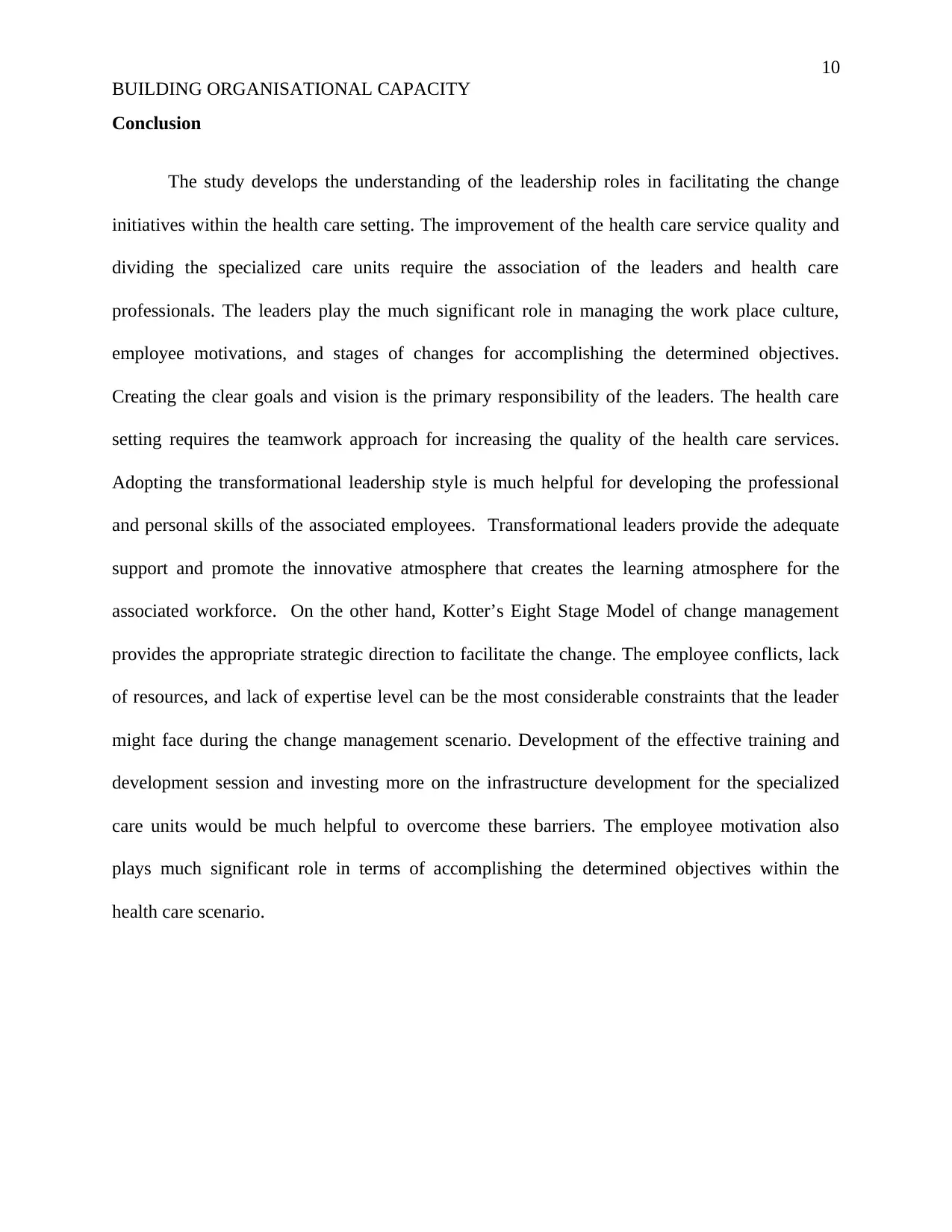
10
BUILDING ORGANISATIONAL CAPACITY
Conclusion
The study develops the understanding of the leadership roles in facilitating the change
initiatives within the health care setting. The improvement of the health care service quality and
dividing the specialized care units require the association of the leaders and health care
professionals. The leaders play the much significant role in managing the work place culture,
employee motivations, and stages of changes for accomplishing the determined objectives.
Creating the clear goals and vision is the primary responsibility of the leaders. The health care
setting requires the teamwork approach for increasing the quality of the health care services.
Adopting the transformational leadership style is much helpful for developing the professional
and personal skills of the associated employees. Transformational leaders provide the adequate
support and promote the innovative atmosphere that creates the learning atmosphere for the
associated workforce. On the other hand, Kotter’s Eight Stage Model of change management
provides the appropriate strategic direction to facilitate the change. The employee conflicts, lack
of resources, and lack of expertise level can be the most considerable constraints that the leader
might face during the change management scenario. Development of the effective training and
development session and investing more on the infrastructure development for the specialized
care units would be much helpful to overcome these barriers. The employee motivation also
plays much significant role in terms of accomplishing the determined objectives within the
health care scenario.
BUILDING ORGANISATIONAL CAPACITY
Conclusion
The study develops the understanding of the leadership roles in facilitating the change
initiatives within the health care setting. The improvement of the health care service quality and
dividing the specialized care units require the association of the leaders and health care
professionals. The leaders play the much significant role in managing the work place culture,
employee motivations, and stages of changes for accomplishing the determined objectives.
Creating the clear goals and vision is the primary responsibility of the leaders. The health care
setting requires the teamwork approach for increasing the quality of the health care services.
Adopting the transformational leadership style is much helpful for developing the professional
and personal skills of the associated employees. Transformational leaders provide the adequate
support and promote the innovative atmosphere that creates the learning atmosphere for the
associated workforce. On the other hand, Kotter’s Eight Stage Model of change management
provides the appropriate strategic direction to facilitate the change. The employee conflicts, lack
of resources, and lack of expertise level can be the most considerable constraints that the leader
might face during the change management scenario. Development of the effective training and
development session and investing more on the infrastructure development for the specialized
care units would be much helpful to overcome these barriers. The employee motivation also
plays much significant role in terms of accomplishing the determined objectives within the
health care scenario.
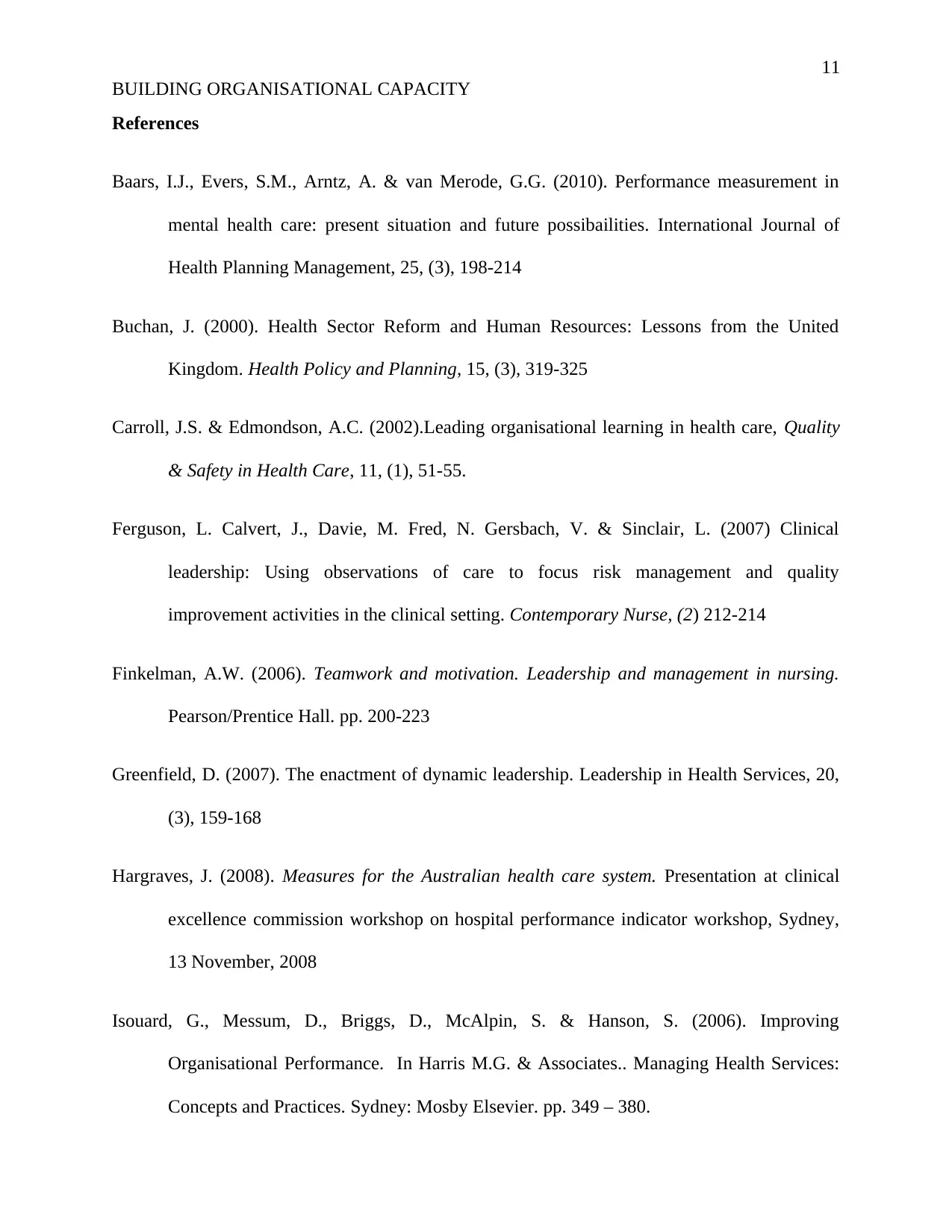
11
BUILDING ORGANISATIONAL CAPACITY
References
Baars, I.J., Evers, S.M., Arntz, A. & van Merode, G.G. (2010). Performance measurement in
mental health care: present situation and future possibailities. International Journal of
Health Planning Management, 25, (3), 198-214
Buchan, J. (2000). Health Sector Reform and Human Resources: Lessons from the United
Kingdom. Health Policy and Planning, 15, (3), 319-325
Carroll, J.S. & Edmondson, A.C. (2002).Leading organisational learning in health care, Quality
& Safety in Health Care, 11, (1), 51-55.
Ferguson, L. Calvert, J., Davie, M. Fred, N. Gersbach, V. & Sinclair, L. (2007) Clinical
leadership: Using observations of care to focus risk management and quality
improvement activities in the clinical setting. Contemporary Nurse, (2) 212-214
Finkelman, A.W. (2006). Teamwork and motivation. Leadership and management in nursing.
Pearson/Prentice Hall. pp. 200-223
Greenfield, D. (2007). The enactment of dynamic leadership. Leadership in Health Services, 20,
(3), 159-168
Hargraves, J. (2008). Measures for the Australian health care system. Presentation at clinical
excellence commission workshop on hospital performance indicator workshop, Sydney,
13 November, 2008
Isouard, G., Messum, D., Briggs, D., McAlpin, S. & Hanson, S. (2006). Improving
Organisational Performance. In Harris M.G. & Associates.. Managing Health Services:
Concepts and Practices. Sydney: Mosby Elsevier. pp. 349 – 380.
BUILDING ORGANISATIONAL CAPACITY
References
Baars, I.J., Evers, S.M., Arntz, A. & van Merode, G.G. (2010). Performance measurement in
mental health care: present situation and future possibailities. International Journal of
Health Planning Management, 25, (3), 198-214
Buchan, J. (2000). Health Sector Reform and Human Resources: Lessons from the United
Kingdom. Health Policy and Planning, 15, (3), 319-325
Carroll, J.S. & Edmondson, A.C. (2002).Leading organisational learning in health care, Quality
& Safety in Health Care, 11, (1), 51-55.
Ferguson, L. Calvert, J., Davie, M. Fred, N. Gersbach, V. & Sinclair, L. (2007) Clinical
leadership: Using observations of care to focus risk management and quality
improvement activities in the clinical setting. Contemporary Nurse, (2) 212-214
Finkelman, A.W. (2006). Teamwork and motivation. Leadership and management in nursing.
Pearson/Prentice Hall. pp. 200-223
Greenfield, D. (2007). The enactment of dynamic leadership. Leadership in Health Services, 20,
(3), 159-168
Hargraves, J. (2008). Measures for the Australian health care system. Presentation at clinical
excellence commission workshop on hospital performance indicator workshop, Sydney,
13 November, 2008
Isouard, G., Messum, D., Briggs, D., McAlpin, S. & Hanson, S. (2006). Improving
Organisational Performance. In Harris M.G. & Associates.. Managing Health Services:
Concepts and Practices. Sydney: Mosby Elsevier. pp. 349 – 380.
⊘ This is a preview!⊘
Do you want full access?
Subscribe today to unlock all pages.

Trusted by 1+ million students worldwide
1 out of 15
Related Documents
Your All-in-One AI-Powered Toolkit for Academic Success.
+13062052269
info@desklib.com
Available 24*7 on WhatsApp / Email
![[object Object]](/_next/static/media/star-bottom.7253800d.svg)
Unlock your academic potential
Copyright © 2020–2025 A2Z Services. All Rights Reserved. Developed and managed by ZUCOL.





